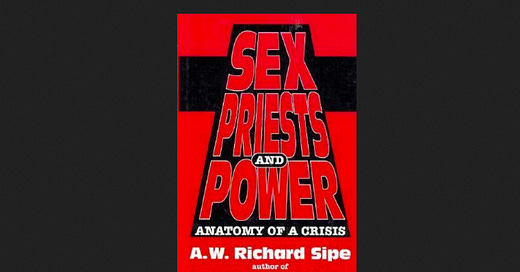"It is not good that the man should be alone" (לֹא-טוֹב הֱיוֹת הָאָדָם לְבַדּוֹ).
Celibacy, as a practice and as an institution of the Catholic church, has brought untold evils into the world, and is responsible for thousands of cases of sexual abuse, including abuse of children. Richard Sipe, a retired Catholic priest is now a married psychotherapist who has counseled hundreds of priests and victims of priestly sexual abuse. His perspective on sexual abuse by priests is Christian (by his own definition), sociological and psychoanalytic.
Perhaps we could only get this kind of reportage from someone who had lived the life of a priest himself, and could approach his subjects as a fellow priest. Yet because he remains a Christian, his anthropologically insightful reportage is mingled with an argument about the real truth of Jesus and the proper functioning of a true Christian church which can only be of interest to Christians. To get the value of the anthropological and psychological analysis of sexual abuse, you have to shlep through quite a few pages of Christian theology, but it’s always interesting to see how another religious tradition thinks about itself.
Sipe says that only two percent of priests are true “Eunuchs for Christ,” having transcended sexual desire and achieved some kind of emotional and spiritual maturity. Maybe they have. However I note that approximately two percent of people in the general population are thought to be “asexual” - lacking any interest in sex anyway. It’s just as likely that those 2% of priests are true asexuals from the start rather than people who have somehow transcended their sexuality. Indeed, Sipe quotes Augustine (on Corinthians) to the effect that chastity is a gift, not an achievement. It seems likely that either it’s who you are or it isn’t - nothing a person does can change it. But that’s where his Christianity comes into play, because he sees this elite 2% as having “achieved” true celibacy. I doubt it. I think it’s who they always were.
Based on 1500 interviews, and innumerable conversations, Sipe estimates that another 8% of priests are “almost there”, and another 40% are working on it and are strongly rooted in at least a five year period of young celibacy, although they may fall out of it later. Whatevs. I see no evidence that they are not, in Sipe’s words, engaged in a miserable, futile “teeth grinding” struggle with their nature as human beings. The thing that Sipes believes they are working to achieve is probably not achievable, except perhaps through exhaustion and old age, and in any case what nobility is there in it? Besides that, who knows how much sexual activity remains unreported in this group?
The remaining 50% of priests are, according to Sipe, living busy sexual lives, with their own hands, with women, with other men (inside the church and beyond it), or with adolescents and children. These sexual lives are an open secret within the church. Many or most of these relationships involve a violation of trust and abuse of power.
A key insight Sipe provides concerns the terrible cost of lacking a language to speak about sex. He finds that priests lack the words to describe sexual desires and emotional intimacy, and are therefore unable to talk about them. Most, he finds, are stuck in a state of emotional and sexual immaturity, and unable to move forward developmentally. It seems little wonder that sexual behavior must burst out, more or less unexpectedly and often abusively, when a whole class of people lacks a language to discuss an essential component of their bio-psychological being, and lacks a practice of regularly doing so. Words and conversation enable us to know ourselves. Without them we are strangers to ourselves and know not what we are, or what we may do. And if priests were inaugurated into a discourse of sexuality in theological seminary - nudged along toward sexual maturity - how many would elect a life of sexual denial? In any case, my understanding is that a declining number of young men are making that choice, thank God.
The church is a structure of male power, says Sipe, promulgating misogyny and secrecy. He heavily emphasizes the conspiracy of silence and self-protection that the Church wraps around the lives of celibate priests. Celibacy, he emphasizes, means “not married” - it does not mean chaste. To maintain one’s position as a “celibate” priest every priest knows that his sexual life must remain publicly hidden and unspoken, but a lack of chastity (from masturbation to sex with adults to abusive sexual crimes, including against children) is something that is often known within the organization. These known-but-hidden, whispered-but-never-spoken secrets, can fester and metastasize and destroy lives.
The picture that emerges in Sex, Priests and Power completes with details everything you might have expected about the humanity distorting, soul destroying, institution of priestly celibacy. Celibacy is a sick doctrine that infects the world’s largest church from top to bottom. It is the consequence of an ancient set of Christian doctrines that Sipe attempts vainly to deconstruct and to suggest must be replaced by something better. An unnamed high ranking American cleric tells Sipe directly that the Church “is rotten from the top down” and celibacy is the central reason. But this rottenness is paradoxically part of the control mechanism by which the power structure of the Church maintains its position and influences its clerics. The institution is locked in a self-reinforcing doctrine of inhumanity that can destroy lives, but that also continues to reinforce its own power.




